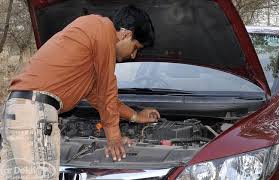Defensive Driving Tip #26: Take Care of Your Vehicle
Defensive driving means taking care of your vehicle. Check your fluid reservoir (if you don’t know where it is, have someone who does show you). Brake fluid levels don’t usually change much so a sudden change in fluid level is a red flag. You should have your brakes checked regularly since preventive work can save you money in large quantities. Let your brake pads wear down too far, and they not only won’t stop you when needed, but they’ll carve trenches into your rotors, and rotors are not cheap to replace.
Don’t scrimp to save money on tires or brakes; buy quality tires you can count on and don’t let anyone install cheap brake parts. Your life depends on them. Last weekend, I passed by the wreck of a vehicle on US85, near Ajo, Arizona. The vehicle had suddenly left the road to the right, cart-wheeled and exploded. It literally burned to the ground. I don’t know why the crash occurred, but it’s certainly possible it could have been brake or tire related, or both. If you lose braking ability or traction, you are no longer in control.
Defensive driving means taking care of your vehicle. Check your coolant level. Make sure you have the cooling system serviced according to the manufacturer’s schedule. Like many others, I once thought the service interval for cooling system maintenance was “optimistic.” I thought my mechanic was “optimistic” about making money because I would stick to the manufacturer’s recommended service plan. Here’s the lesson I learned: if you let your cooling system go too long without service, the coolant loses its alkaline nature and becomes more acid. Guess what “more acid” does to your engine parts? My failure to adequately service my cooling system (involving two or three service appointments at about $50 each over 100,000 miles) led to a more than $1000 repair bill later. I thought I was saving money, but my water pump, thermostat, radiator and heater core, as well as all the hoses, had to be repaired or replaced. A simple flush and fill every two years would have prevented most of that damage. Your mechanic says, “Pay me now, or pay me more later.”
Defensive driving means taking care of your vehicle. Listen to the sounds your vehicle makes. They will often tell you when things are going wrong. A metallic scuffing sound (and feel) underneath your foot can mean your brake pads are worn and metal parts are scraping on those expensive rotors. Clanking and rattling can mean you have a steering problem. Whirring or shrieking noises under the hood can mean you’re about to lose a water pump, a power steering pump, or maybe a belt. Ratcheting noises while turning may mean that your CV struts are about to go. When you hear a noise, get it checked. Waiting to see what happens next can mean lots of extra dollars spent, not only for towing, but quite often, an early repair means LESS needs to BE repaired.
Defensive driving means taking care of your vehicle. Check the oil, and make sure you keep good quality, fresh oil in the vehicle, at LEAST as often as the manufacturer requires. I don’t use the most expensive oil out available, but I use the grade specified by my owner’s manual and I make sure it meets the rating required — SG, SH, whatever the maker says you need. The letter grades are printed on the oil bottle label. You should always use the correct grade or higher (SJ is later than SG, for example).
Pay attention to your car’s needs—and it will take you where you want to go on your roadtrip—safely!
If you do get a ticket take our Defensive driving course www.2passdd.com

